122nd Avenue is part of Portland. But it doesn’t look like “Portland.”
Instead, it looks like America. And that means it’s a pretty big opportunity.
With two travel lanes in each direction, a center turn lane, a pair of door-zone bike lanes that sometimes squeeze narrower than four feet and a little-used parking lane along the curb, east Portland’s most important artery would look right at home in Albuquerque, Kansas City, Columbus, Rochester or Greensboro.

(Image: Streetmix.net)
But what if 122nd Avenue were different? What if, here outside Portland’s historic street grid, where almost every trip has to use a massive artery like this one because the side streets don’t connect, we could find a way to serve not only the 85 percent of east Portland households that own cars, but the 15 percent that don’t?
What if you could use 122nd Avenue’s great problem — its huge, empty expanses of pavement — to turn it into a place where getting around without a car feels like something other than a hassle, a burden or a shame?
If you could do that, you’d have more than just a great place for Portlanders to live, work and do business. You’d have a template.
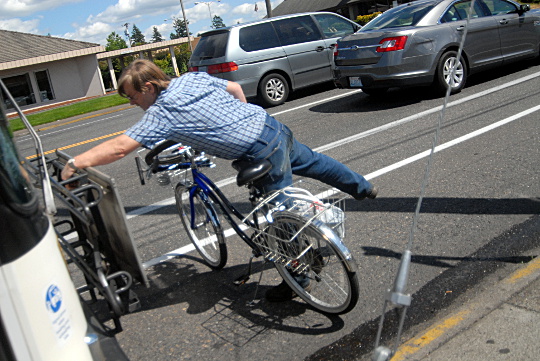
Some people say Portland doesn’t need the physically separated bike lanes that San Francisco, Boston and Indianapolis have been building rapidly: that our neighborhood greenway network and our narrow, stoplight-calmed downtown streets are good enough for everyone who might ride a bicycle. But even if that’s the case in the central city, east Portland is an entirely different story.
Advertisement
These were the ideas that about 25 Portlanders, two North Carolinians, one Oregon City visitor and I tackled early Sunday evening on Bizarro 122nd Avenue, a PedalPalooza ride down 122nd that invited people to think about an alternate-universe version of the street. Here’s what we asked:
What if the city connected more of the private parking lots that line this street, removing some of the many driveway entrances and reducing the constant danger of turning cars?
What if the city eliminated the almost completely unused on-street parking lane and used the space for a six-foot-wide bike lane separated from traffic by bollards or curbs?
What if, like the soon-to-be redesigned Figueroa Street in South Los Angeles, the city moved stops for a newly frequent bus line onto platforms to the left of the bike lane, so buses could stop and start quickly, comfortably and without constantly zigzagging across the bike lane?
What if, at major intersections like Division and Powell, the city removed its scary sharrow-marked turn lanes and instead added eyelet-shaped curbs that created protected intersections where two sets of protected bike lanes could safely and intuitively intersect without preventing right-turning car traffic?

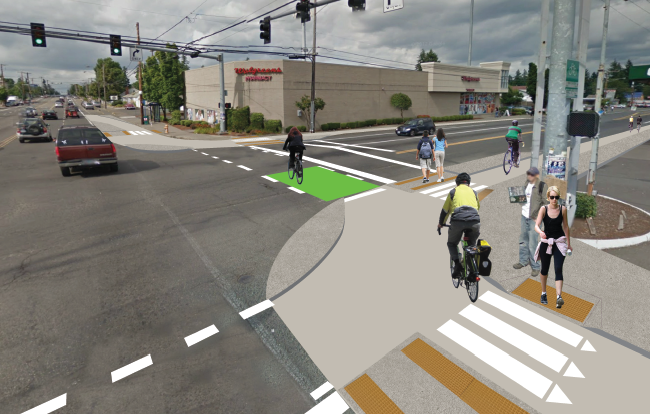
(Rendering by Nick Falbo)
Along the way, we looked at some of the things that are making the 122nd Avenue area better: the new flashing crosswalk beacon outside Midland Library, the busy but calmingly narrow Burnside Street, the eight-foot buffered bike lanes on Southeast Holgate. Many of the participants, a mix of curious bike-lovers, dedicated transportation wonks and interested locals, joined in with questions or additions. And afterward we headed west on the Springwater Corridor for beers and dinner at Cartlandia, the thriving multicultural food cart pod outside Lents.
On Friday, a few days before Sunday’s ride, I’d called Portland Bicycle Planning Coordinator Roger Geller to ask what possibilities he saw for 122nd. North of Powell, he said, converting the unused parking lanes to high-quality bike lanes was the most viable option for the street; south of Powell, traffic is low enough that the road could probably be narrowed to two travel lanes, a turn lane, bike lanes and parking lanes without much congestion.
“But we haven’t really looked at it that much,” he noted.
Projects of this scale would cost millions of dollars. Geller’s bureau currently has $1 million a year to spend on all street safety projects citywide.
But according to Geller’s calculations, east Portland has great potential for biking, in part because so many people who live here can’t afford to own cars. If biking could be made safer, more comfortable and less stigmatized, bikes could be a very popular way to get around.
Today, about 1 percent of commute trips east of 82nd Avenue happen on a bicycle. Geller said travel behavior data from cities with low-stress bike networks shows that this could increase to about 15 percent of work trips with a complete network of protected bike lanes and neighborhood greenways.
If hubs like Gateway, Midway or Lents became job centers, Geller said, that figure would be even higher.
What about the notion that east Portlanders don’t want to dedicate road space to high-quality bike lanes? Geller said he likes to look at a the steady flow of people here who ride their bicycles on the sidewalk — using the only available separation between bikes and cars.
“To my mind that just says, ‘These are people who want a cycle track,'” Geller said.


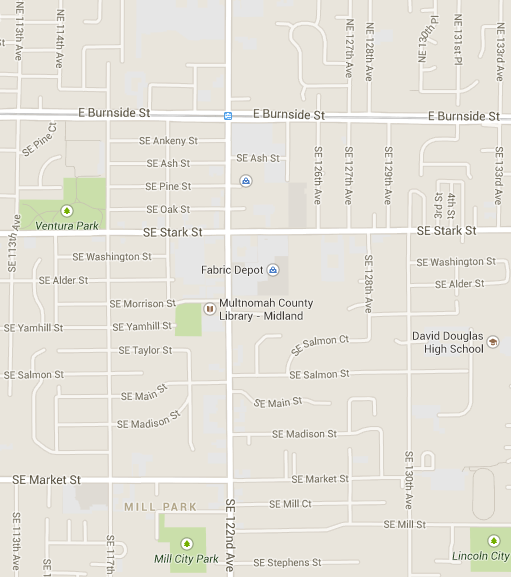
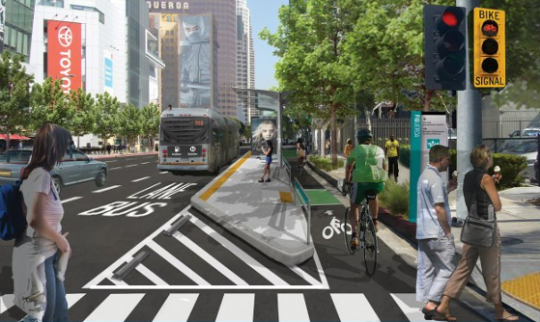


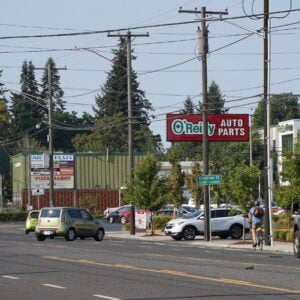
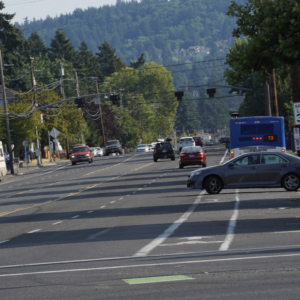

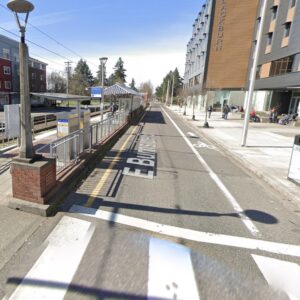
Great potential, ideas, and story- thanks! Now just to get the momentum and will to build it out. As for this, they are wrong: “Some people say Portland doesn’t need the physically separated bike lanes that San Francisco, Boston and Indianapolis have been building rapidly.”
BRT on 122nd would be an obvious nice-to-have. Come to think of it, FREQUENT SERVICE on 122nd would be a nice to have.
I just heard Neil McFarlane say 122nd Ave IS the next frequent service line at the street fee hearing before the Portland City Council a couple weeks back. I hope it happens. But he also qualified by asking the City to invest in the sidewalk network so that the increased service was more accessible to area residents and businesses, which sounds fair to me.
It sure would be nice to hear the City talk about funding priority safety and livability projects like this someday.. When I look at cities like Vancouver BC with the extensive traffic calming implemented by the City, I can’t help but wonder where Portland went wrong and now PBOT apparently sits idle. i’m sure there’s a story there, but I don’t think any of the local papers or blogs have the time, funding, or lack of bias to pull it off accurately.
Why not do a potential fix as a pop-up project for a weekend for 5-10 blocks?
122nd is a nightmare to cross, I only use designated crosswalks or lights because the road is so freaken wide and cars go really fast. I’d rather take the neighborhood streets if i have to go north south.
“But we haven’t really looked at it that much,” Yup too busy micro managing 28th Ave.
Much more can be done for cycling in Portland if they actually tried to bring the level of infrastructure to the outer east side as there in the rest of the city.
How hard would it be to punch through some of the parallel streets to make them continuous? I assume there are buildings in the way in some cases; in others, Eminent Domain might be all it takes.
Unless we are once again talking about displacing low income people for the benefit of a small minority. Sounds familiar.
Well that escalated quickly. There would be tremendous benefits to the neighborhood by providing a more connected grid of streets, and such changes do not imply widespread displacement.
In fact, these connections don’t need to be full streets. In many cases a bike/ped path can be established between buildings in such a way that doesn’t remove any buildings.
In the area around 122nd, PBOT’s Division-Midway Neighborhood Street Plan is looking at precisely this question and exploring potential solutions – and they’re doing it hand in hand with then neighbors.
http://www.portlandoregon.gov/transportation/63384
More than just a small minority would benefit from a better-connected neighborhood. How about more kids being able to walk to their (woefully underdeveloped, as pointed out by the Oregonian) neighborhood parks? Suppose there’s any benefit in that?
On most of the streets you suggest doing this to, the buildings you speak of are houses or apartment buildings. Would you displace the families that live there with eminent domain?
Along the edges of the mega-blocks, where the density is high and the apartment buildings are, we already have (kind of by definition) the necessary connections from the arterials to the internal neighborhood streets.
Where things break down is neighborhood streets that don’t connect through to the other side of the mega-block. The missing connections are mostly in the middle of the mega-blocks, where density is lower (and, often, lot sizes are larger), so in many cases it may be possible to put through a bike/ped path without anyone losing their home.
the designs above are starkly motorist-centric. a narrow meandering bike sidewalk does not compete with FIVE 12 foot-wide motor vehicle lanes. if we want to encourage active transport in east portland we need road diets, traffic calming, signalling and aggressive speed reduction. narrow, cheap, unsignalled bike sidewalks are simply not competitive with the current auto-centric concrete jungle. imo, we need to discourage casual motoring, support public transport, and allocate real space on the road for cycling and pedestrians.
“To my mind that just says, ‘These are people who want a cycle track,’” Geller said.
and why would they not continue to use the mostly empty sidewalk? at least it’s protected by a curb and has signals at intersections.
Where did you get five 12-foot motor vehicle lanes from. Look at the graphic again.
OK…5 hawthorne-style 10 foot lanes.
This facility would evoke howls of protest in the Netherlands/Denmark, Germany, Belgium or Sweden (nations with 10% or higher national cycling mode share). IMO, it manages to be relatively expensive and sub-par at the same time.
There is plenty of space for 9-10 foot wide buffered bike lanes on 122nd. Moreover, as funding becomes available this *allocated* space could be protected with turtles, rumble strips, and/or bollards (no bollards anywhere near intersections please). Even more importantly, PBOT could begin re-striping these roads *now* as part of normal maintenance. The existing 4-5 foot wide bike lanes in outer east portland are a disgrace. Lets start restriping them now, not in 2030, 2040, 2050…
Buffers would certainly help compared to the nerve-wracking situation today. They’d also certainly last longer than bollards, which would be destroyed frequently.
Signals are an interesting issue for a protected-lane pipe dream. All the big intersections on this stretch are fully signalized, and most of the unsignalized ones are purely residential, at least right now. Chris Monsere told me last week that he thinks the protected intersection concept could be pursued in some cases without signalization, but Falbo’s concept includes signals as one of its key features.
The sidewalk isn’t actually that empty, compared to the parking lane or the current crappy bike lanes. Most of the people there are interacting with the bus one way or another.
buffered bike lanes are inexpensive (especially during re-paving and/or re-striping), more effective than the terrible status quo, and carve out space for future upgrades in infrastructure. the buffered bike lanes on holgate are fading but are still a joy to ride. even the cheap double lined bike lane on close in barbur is well respected by motorists. there is absolutely no reason pbot could not implement buffering and lane reduction and/or restriping in east portland as part of normal maintenance.
as others have stressed, 122nd is daunting because it allocates too much “protected” space to motorvehicles. giving bikes an extra foot of space does little to reconfigure this situation. moreover, on a higher speed road a physical barrier or something that really discourages encroachment would be more appropriate (turtles or larger jiggle bars/bott’s dots).
because then they would get a ticket for failure to use the mandatory bike lane… which would cause them to stop cycling completely…
cars win again!
There is nothing in Oregon law that says you cannot ride on the sidewalk when there is a bike lane on the street.
I do like that idea of eliminating parking along 122nd … it’s rarely used anyway.
there needs to be a protected crossing on 122nd between Powell & Division
The ADA wheelchair access ramp right in front of mcdonalds at 122 & Glisan sticks out so far into Glisan that a bike is forced into the traffic stream for about 10 feet when rolling east to west on Glisan
The auto dealer’s car carriers park into the bike lane at all the Tonkin dealerships. They need a better solution.
Did you notice the 2 headed bike rider pictogram on the southbound lane just South of 122nd & Halsey (in front of gas station) ?
I have NEVER seen a single bike on Holgate from 122 to 92
The MAX tracks crossings suck.
Thanx for coming out our way , not all BP.O readers cycle downtown.
“The auto dealer’s car carriers park into the bike lane at all the Tonkin dealerships. They need a better solution.”
Yep.
“I have NEVER seen a single bike on Holgate from 122 to 92”
What? I see bikes there not infrequently.
I’ve seen myself biking there every now and then.
i saw 5 today in 15mins!
My huge concern is getting across the street safely. 122nd is a very wide street and people tend to drive faster here. It’s sketchy as hell to cross the road without the fear of dying.
What also happens is that because the people living out there tend to be either low-income, disabled or minority, the city JUST.DOESN’T.CARE to make necessary improvements to not only the roads, but Trimet offering safe, well-lit shelters, frequent, extended services, benches, etc. I work as a subsidized housing advocate and my organization is moving a lot of clients out to east county and surrounding areas of town because that’s where it is affordable. Unfortunately there are not the resources available. Lack of grocery stores, clinics, libraries, employment resources, etc. Everything is concentrated to the center of town and that’s just not convenient to people that may have mobility limitations.
Well, 20 years ago they didn’t care about the Pearl, Mississippi, Alberta, or Division….
And that is one of the “problems” with big improvements like the ones suggested here. Infrastructure improvements of this scale are often perceived as one of the first steps to gentrification of an area. Often they get resistance from the locals, not because the they don’t want or use them or don’t like bikes. But because they’re afraid the housing which they can often barely afford now will suddenly increase as a result of the improvements.
And though I would say this kind reasoning might be viable for West of the 205, I doubt gentrification will go as well or fast east of it. The suburban “feel” and layout of the houses and neighborhoods and aren’t currently in vogue, and will be a hard sell (to people and commercial) unless housing trends change.
I recall that most of the children in Portland live east of the 205. Making it easier for future generations to get around without having to buy a car seems like a good goal. Converting the parking lane to bike lane and making the current bike lane a buffer would cost about $6k/mile for the bike symbols for both directions and another $7k/mile for hatching out the bike lane every 10 feet, again both sides. So, at $13k/mile, plus some overhead for labor, say 40%, you get to about $18k per mile. 122nd, Sandy to Foster is about 5.6 miles and at $18k/mile it would be about $101,000 to convert the parking lanes to bike lanes, next month. Most greenways aim for about $250k/mile. Where you don’t need two lanes for autos, use the outside lane to further buffer the bike lane.
Signals are part of the problem on busy streets like 122nd – they have built in delay that necessitates turn lanes to store (park) cars waiting for the next green phase. Go fast, stop, go fast, stop, go fast, stop. Anyone else see a problem with this form of motor vehicle progression?
“Converting the parking lane to bike lane and making the current bike lane a buffer would cost about $6k/mile for the bike symbols for both directions and another $7k/mile for hatching out the bike lane every 10 feet, again both sides. So, at $13k/mile, plus some overhead for labor, say 40%, you get to about $18k per mile.”
peanuts.
part of the cost can be defrayed by re-striping when normal road resurfacing or maintenance is necessary.
So what’s the solution? Just leave it the way it is and continue to complain about how East Portland gets not funding? Or are you thinking of doing something, just something else?
Slowing things down could actually speed them up. If most of the high traffic streets reduced the speed limits to 30 mph and a few of the signals were replaced with modern roundabouts, the daily travel delay would probably drop.
Good point! One of the things we often hear is that while roundabouts are more efficient for many intersections, while also reducing the severity of crashes and costing less to build than signalized intersections, they do take up more real estate and are hard to retrofit into the older parts of Portland.
Well, guess what. At a lot of the intersections between major arterials in East Portland, we’ve got plenty of room for roundabouts.
The real estate objection is overblown. Modern roundabouts take more corners at an intersection, but signalized intersections have to store cars waiting for the green turn arrow. These lines of cars stretch out from the intersection and the space needed often can affect as much total area, but is spread down the street over multiple properties.
“They don’t want it out there” and “it’s too suburban for bike infrastructure” is something often repeated here – it’s elitist. Someone said “the city doesn’t care about east Portland” – that’s just a reflection of the attitudes west of 82nd and the “bike community.”
Go south of Holgate and east of 82nd and you will still see bikes, but much less bike infrastructure.
I wasn’t and didn’t say that people don’t want, need, or wouldn’t use bike infrastructure out there/here. I was just pointing out a couple of things.
1) That big transportation projects are often are the first big sign of gentrification. And that is not necessarily considered a good thing by the locals especially the poorer ones. It happens every time.
2) That the gentrification that will (it has too at some point with the UGB) occur in outer east side will be slow. Partially because of the street design, the mega lots (which are harder and more expensive to redevelop), and the house styles which lack that old Portland Craftsman Cottage and/or Victorian charm which is a huge part of the appeal west of the 205.
I was just pointing out some observations. I was by no means implying that we should do nothing. I personally feel the opposite, and think developments west of 39th (sorry Chavez – some habits never die) should be stopped until the middle and outer rings have had a chance to catch up. (middle SE is catching up fast, but I’d say NE 39th to the 205 needs a lot of work too).
It’s part of the thing I find so funny about the 28th street debate is that even if we did nothing to 28th and left it as is, it’s much better than nearly everything east of 205 (and even parts of that MUP are horrid).
I almost always comment on any new development in the city core as being unnecessarily because the core has enough, and because more people live out in the middle and outer sections of the city than live in the core.
I think we’re getting into a chicken/egg argument. More people bike in inner neighborhoods, so more people want bike infrastructure. Less people bike in outer neighborhoods so maybe there is less demand now. But to increase demand we have to improve the infrastructure.
Sounds like you’re of the “build it and they will come mindset”, which I tend to agree with.
Gentrification is most likely inevitable in most of this city (due to UGB and the size), as long as it continues to be desirable. But maybe in 10-15 years Portland won’t be as popular?
As far as I know, the Midland Library is the biggest bike destination on all 122nd. The racks are usually filled up.
Was happy to get the strobed crossing there , but it isn’t perfect. For some reason, it’s not a straight through passage. You have to do a hard right, then dead ahead a bit, then a hard left to cross the island.
Never figured out why they made it that way.
Some of the car carriers park in the center divider and block view of the strobes.
On Powell from 122 to 136 is a high density area, but there is NO secure crossing in that half (?) mile stretch. Jaywalking is the only method. In fact, jaywalking is common as crossings are so sparse on the busy E. Portland streets. BUT they did put in a little used crossing at 141 & Powell.(why ?)
Who picks the crossing locations ? Do they throw darts at a map ? Most, with the exception of the 2 library crossings, seem arbitrary.
I’d bet that the one at Midland is the most used one in the whole Metro area. It sure doesn’t inspire confidence when the voice announces “cross with caution, cars may not stop”
The red light crossing , just South a bit from the Safeway at Powell confuses many drivers. You GO on a flashing RED.
Z-crossings are used to focus pedestrians’ attention on the traffic stream they are about to enter. It is not required for pedestrians to activate the warnings to cross the street, nor does a yellow beacon require motorists to stop. In fact, motorists are not required to stop unless the pedestrian is on the right side or at the island attempting to cross as the motorist approaches, and that has nothing to do with the beacon.
Flashing red has alwasy meant stop, then go if it is clear. We really need to require everyone to retake the written test every four years. It’s an essential component of the Safe System street design that users know the law.
Cartlandia! In Brentwood-Darlington. YES, it’s part of Portland.
i think 122nd is part of the streetcar master plan. not that it will ever happen, but there has been some planning around it.
You might be thinking of 102nd, where the land use is slightly more streetcar-friendly:
http://portlandafoot.org/w/Streetcar_System_Concept_Plan
But yeah.
We concentrated a lot of our bikeway improvements in inner Portland because that was the low-hanging fruit, the biggest bang for the buck where you had higher density (not only of population, but destinations closer together) and a population eager for the change. That did make a lot of sense. As a first step.
Maybe one of the big reasons we’re “stuck at 6%” overall, even with many parts of central Portland having two or even three times that mode share, is that we’ve failed to extend a reasonably usable and safe bikeway network across the entire city.
Seems like all we did out there was to stripe 5′ lanes, well away from the security of the curb, along scary-ass roads like Division, Glisan and 122nd. That’s ridiculously inadequate.
We need to:
1. Improve connections for bikes and pedestrians on quiet non-arterial streets, so more people can get around by foot and pedal without having to spend so much time on the big streets. That means punching through connections where they don’t exist in the middle of the mega-blocks, and improving the inevitable crossings between these routes and the mega-arterials. Probably we need more full-on Red/Yellow/Green stop lights and not just amber flashers to really make this work. Focus needs to be on coherent longer east-west and north-south through routes with no more meandering than necessary, with solid and easy connections to schools, parks, grocery stores and employment centers.
2. Improve the safety of the major arterials for both pedestrians and cyclists. There are a lot of great ideas above for improving 122nd, and I like the idea of turning it into a pilot project for What Can Be Done. As Kunstler pointed out, “here, broad commercial boulevards … roll out remorselessly into the suburban mists.” The reason central Portland was easy to bike-ify, and East Portland is more difficult, is that the latter looks like most of America. But if we put our heads together and really figure out how to make it better, we can provide perhaps a better example for the rest of the country than what we’ve done so far.
The good news is that there is plenty of ROW on 122nd, unlike NE/SE 28th!
But look at the struggles to get private investment in Gateway and Lents, despite substantial public investments there. Without that not much really changes; with it, sometimes, too much changes. The challenge is how to find the balance between too little and too much re-development.
And how do you create “place” on such a wide street in which pedestrians and bicyclists feel like aliens as cars whiz by. 4-6 story apartments on Division are transforming the stretch west of Chavez into a “place,” but the proportions are such that for that to work on 122nd, buildings would have to twice as high or more…like in the picture from LA.
I can tell you’ve never been there. They are already stopped when the reds start flashing.
The lights (doubles) go from green to yellow to solid red then to flashing red and back to green.
Most vehicles sit through the 2 different reds and wait for the green, since they’ve not seen this sequence before and nothing was ever explained.
I think you guys were talking about different things. I think Paik. was referring to flashing at a stoplight (like when the power goes out, etc.), while you were talking about the waning phase of a crossing signal.
The location in question is the Pedestrian Hybrid Beacon on 122nd at the Bush Neighborhood Greenway. It has no green, it rests in off. When activated by a pedestrian or cyclists, the beacon begins flashing yellow, goes to solid yellow, then goes to solid red. After the bike signal for Bush goes to red, the beacon on 122nd goes to flashing red. This means traffic that has stopped can start moving if the crosswalk is clear and vehicles that are approaching must stop, but can go after stopping if the crosswalk is clear.
I completely understand the location I am referring to.
We don’t need bike lanes on 122nd. We don’t need sharrows. We don’t need buffers.
We need jobs. When we have employment opportunities that don’t require people to drive long distances to the central city or Washington County, more people will ride bikes.
But right now, most parents leave the house early in the morning for the long commute, children pile on the school buses for the long ride, and everyone gets home well into the evening.
This ain’t Central Portland. The challenges go way, way deeper.
Strong case. See my follow-up post on central city biking privilege for a bit more on this.
One of the most interesting conversations from this ride was with someone who’d come up from Happy Valley. He said it’s his belief, informed by StrongTowns.org, that a reason 122nd Avenue is so much less economically productive than closer-in neighborhoods is that it’s so auto-oriented. Until streets like 122nd become more pleasant places to spend time, who would locate an office there, or a nice restaurant, or the amount of housing that can attract major commercial development? Most of the businesses here are for selling or servicing cars, or for feeding people while they’re in their cars going somewhere else. Those are important and necessary enterprises (well, maybe the first two) but they don’t create many jobs per acre.
Part of the problem here is that there’s simply not much that a local government can do to create jobs, other than change the street environment in ways that lure private investment. Just look at the city’s struggles in Lents: the $96 million investment may finally be starting to pay off in the wake of big sidewalk improvements and 12 acres of public land purchases.
I’d like to find a way to write a post about East Portland job growth before the week is over, but haven’t come up with a solid methodology/angle yet. I’ll find a way to do this eventually, though. Suggestions encouraged.
Jake is right, East Portland needs living-wage jobs! And the way to start building decent jobs is by building desirability for the east side neighborhoods and commercial corridors. But new mixed-use development, and new mixed-uses for existing buildings, both of which will bring jobs, costs a great deal of capital money. Developers and entrepreneurs need to be attracted to the area first to bring in that kind of money. And the sprawl development pattern has to change to compact, mixed-use; the City can help through zoning, Form-Based Code or other policies, and through giving financial incentives, but the latter can only be part of the draw, and only a temporary one.
The cheapest and quickest way to start is with active transportation. If traffic is calmed, more cyclists and pedestrians will come, who spend more money than drivers (yes, there is now lots of data to support this). Traffic calming can also reduce crime, and collisions, increasing the perception of safety for residents and visitors. Then beautification can start, starting with the roadways, and even as part of bike/ped projects.
Then the area starts to look and feel like a destination that can attract new business, and developers will become interested, and the jobs will follow. (Yes, this success has happened in many places in the U.S.; of course, the unintended consequence can be displacement of some long-term residents, which the right City policies could mitigate). But without transportation options and calming, and then compact, mixed-use development, the east-side story will remain the same…
From Clackamas Town Center to the Western Star truck plant on Swan Island in N. Portland is 50 minutes via MAX Green Line and the 85 bus; about the same or better from Rockwood via Blue Line; or Parkrose via the Red Line. Lloyd Center and Central Eastside jobs are even closer, and downtown not much more. PCC has an expanded campus at 82nd & Division where job skills training is a high priority.
More Good jobs in E. Multnomah county is a long shot, but the connections are there for where the jobs are. Where are the jobs now east of I-205?…Adventist Medical Center, the chip plant in Gresham, some medical clinics at Gateway. What else? The car dealerships on 122nd!
There are a few warehouses and factories along Foster (accessible from Springwater), but you are for sure correct.
Does Airport way count as part of “East Portland” because Danner, and a lot of other factories, warehouses and light industry is out along Airport way, and BikeTiresDirect.com of course too.
I spent a few hours riding around East Portland today, inspired by Jonathan’s series earlier this month, to get a feel for the area by bike. I rode significant sections of Foster, Holgate, Division, Burnside, Glisan, Halsey, 122nd, 148th and 162nd, as well as some of the more minor neighborhood greenway-type streets like Mill and parts of the 130s bikeway.
My biggest a-ha moment was the realization of why East Portland’s mega-arterials seem so scary for cycling, even with bike lanes. I mean, I bike on the westside daily, braving streets like Hall or Murray that also have 5-6′ bike lanes and two lanes of car traffic each direction, but somehow I find the Beaverton arterials much less intimidating. It dawned on me that the parking lane to the right side of the bike lane is the biggest problem.
The westside arterials that I frequent generally do not have parking on them, and that makes them appear narrower. And while it might not be entirely rational, there is something about riding next to the curb that somehow feels a lot safer than riding 10-12′ away from it while 45mph traffic whizzes by (in lanes that themselves aren’t actually very wide).
I think a bike lane next to parking can work on a narrower street with 1 general lane in each direction, as long as the bike lane is positioned to avoid door-zone conflicts. But especially on East Portland’s 5-lane arterials, where the vast majority of that parking sits empty, it makes the road appear 75′ wide when barely more than 50′ is actually available for use by car traffic. Combine that with the excessive distance between traffic signals, and you’ve got way too much high-speed racing from stoplight to stoplight.
Most of the roads I mentioned above could use a diet, and it might not necessarily even involve removing travel lanes. Get rid of the barely-used street parking, protect the bike lane, and delineate the car-travel zone in a way that makes the road appear as narrow as it actually is. And put in way more signalized pedestrian crossings, all over Deep East: there’s no reason for ANY street in a populated area to go more than 6-10 blocks at a stretch (that’s 1/3 to 1/2 mile) without a stoplight.
And contrary to my above post earlier this month, where I put quiet neighborhood greenways as roughly equal importance with arterial calming: after researching and doing today’s ride, I think taking on the arterials will ultimately make a bigger difference in safety.
The reason is not that the neighborhood greenways aren’t important, but that they’re better than I realized. Once I started mapping out my route for today, I discovered that there are more and better cross-neighborhood connections on quiet streets than I was aware of. People aren’t forced out onto the arterials to make short neighborhood connections as much as I thought. I could only wish for such good side-street connectivity where I work on the westside, and in SW Portland between home and work.
As is about to happen with the 130s Greenway the quiet routes need to be better marked, which will help divert cyclists taking longer trips away from the scary arterials. But more critically, they need better crossings of the mega-arterials, which again highlights that those major arterials are the big problem. Fix the big streets, and you fix East Portland for cyclists.
One more thing: I rode a pretty good chunk of Glisan, westbound along the edge of Glendoveer Golf Course. Glisan is one of the worst streets in East Portland for having long stretches with no safe pedestrian crossing. But not only that, the section along Glendoveer doesn’t even have a freaking sidewalk! Where there are parked cars, if you don’t want to take the lane you have to ride on a narrow stretch of gravel singletrack. How in the world is Metro – which owns Glendoveer – exempted from having to put in a sidewalk along their property??
And BTW Glisan does appear wide enough for a bike lane if the curbside parking were removed – except that a few new bioswales have been put in (including one that’s at the top of the rise, so I don’t know how much stormwater it could possibly divert from the sewer system, but that’s an aside). And brainstorming just a moment ago, I just thought of a possible solution to the problem of all these new bioswales reducing the amount of room for bike lanes: how about continuing the bike lane THROUGH (i.e., OVER) the bioswale as a 3-4′ wide path? It would need to be a permeable surface, such as the metal grating material used on parts of the Eastbank Esplanade, but I’d think we could come up with something that would allow cyclists to ride right over the bioswales while allowing runoff to fall into the swale.